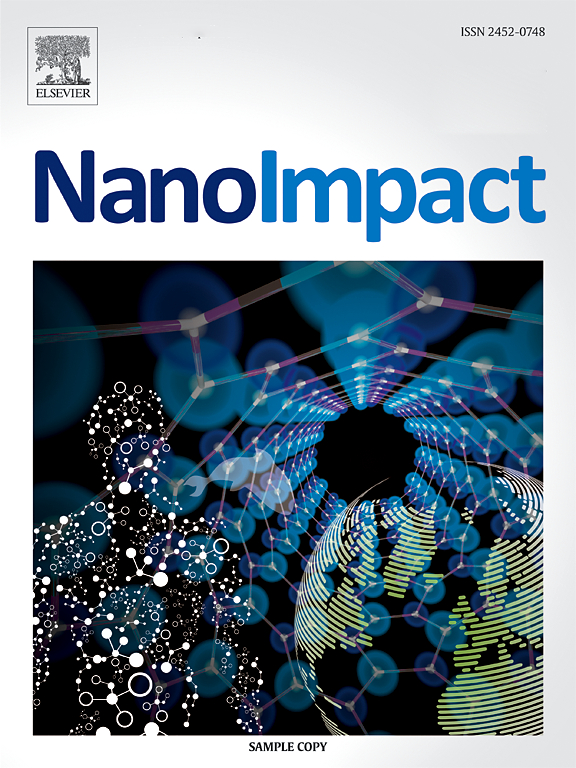Gastrointestinal dysfunction as the main performance of the oral toxicity of titanium dioxide nanoparticle on gastric ulcer rats
IF 5.5
3区 环境科学与生态学
Q2 ENVIRONMENTAL SCIENCES
引用次数: 0
Abstract
Titanium dioxide nanoparticles (TiO2 NPs) have promising applications in food additives and pharmaceutical dressings, raising concerns about their oral safety. The current studies mainly focus on healthy groups, and the effect of TiO2 NPs on the patient population is rarely known. Here, a comprehensive toxicity study of TiO2 NPs (75 ± 15 nm, anatase) in gastric ulcer rats (male 8-week old Sprague-Dawley rats) is reported following oral exposure at dose of 0, 10, 50, 200 mg/kg body weight per day for 30 days. The gastric ulcer rats were produced by submucosal injection of acetic acid solution into the rat stomach. The healthy rats were used as the normal control. We evaluated nanoparticle biodistribution, systemic toxicity, and gastrointestinal function indices in the rats. Our findings indicate that oral administration of TiO2 NPs resulted in minimal intestinal absorption and transport with limited systemic organ toxicity. The internalization of TiO2 NPs and activation of mast cells in the stomach tissues, along with the low serum levels of histamine and IgE, suggest a localized allergic reaction rather than a systemic one. Furthermore, the notably reduced plasma levels of D-lactate and the activity of diamine oxidase (DAO) indicated the upregulation of intestinal barrier function. These statistically significant results indicated that gastrointestinal dysfunction was the main performance of the oral toxicity of TiO2 NPs on gastric ulcer rats, emphasizing the importance of controlling the intake of TiO2 NPs in patients with gastric ulcers.
胃肠功能紊乱是纳米二氧化钛颗粒对胃溃疡大鼠口服毒性的主要表现。
二氧化钛纳米粒子(TiO2 NPs)在食品添加剂和药物敷料中有很好的应用前景,但其口服安全性引起了人们的关注。目前的研究主要集中在健康人群,TiO2 NPs对患者群体的影响尚不清楚。本文报道了一项全面的胃溃疡大鼠(雄性8周龄Sprague-Dawley大鼠)口服0、10、50、200 mg/kg体重/天剂量的TiO2 NPs(75 ± 15 nm,锐钛矿)的毒性研究,持续30 天。采用胃粘膜下注射醋酸溶液制备大鼠胃溃疡模型。以健康大鼠为正常对照。我们评估了纳米颗粒在大鼠体内的生物分布、全身毒性和胃肠道功能指标。我们的研究结果表明,口服TiO2 NPs的肠道吸收和运输最小,全身器官毒性有限。胃组织中TiO2 NPs的内化和肥大细胞的激活,以及血清组胺和IgE的低水平,提示是局部过敏反应,而不是全身性过敏反应。血浆d -乳酸水平和二胺氧化酶(DAO)活性显著降低,表明肠道屏障功能上调。这些具有统计学意义的结果表明,胃肠道功能障碍是TiO2 NPs对胃溃疡大鼠口服毒性的主要表现,强调了胃溃疡患者控制TiO2 NPs摄入量的重要性。
本文章由计算机程序翻译,如有差异,请以英文原文为准。
求助全文
约1分钟内获得全文
求助全文
来源期刊

NanoImpact
Social Sciences-Safety Research
CiteScore
11.00
自引率
6.10%
发文量
69
审稿时长
23 days
期刊介绍:
NanoImpact is a multidisciplinary journal that focuses on nanosafety research and areas related to the impacts of manufactured nanomaterials on human and environmental systems and the behavior of nanomaterials in these systems.
 求助内容:
求助内容: 应助结果提醒方式:
应助结果提醒方式:


